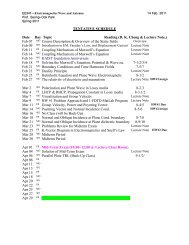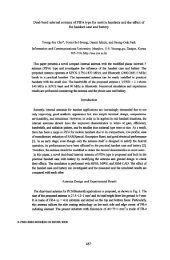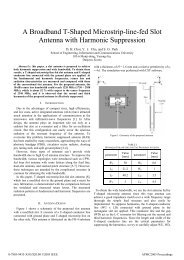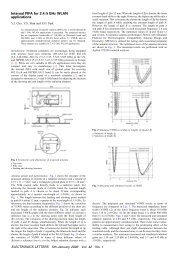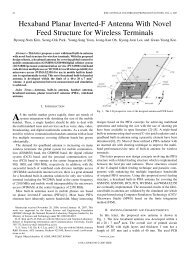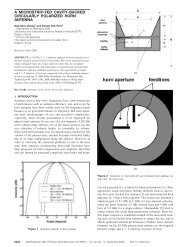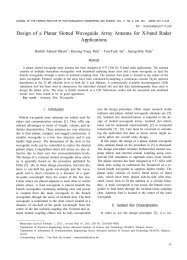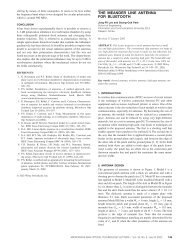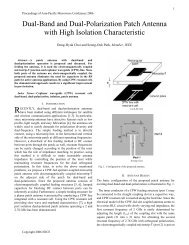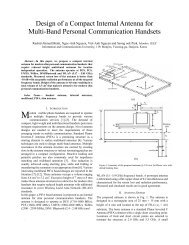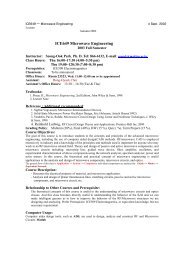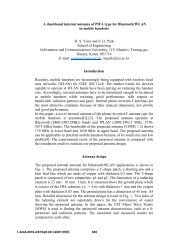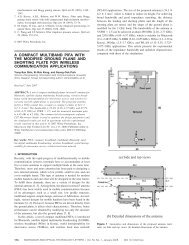Optoelectronic and microwave transmission characteristics of indium ...
Optoelectronic and microwave transmission characteristics of indium ...
Optoelectronic and microwave transmission characteristics of indium ...
Create successful ePaper yourself
Turn your PDF publications into a flip-book with our unique Google optimized e-Paper software.
410 IEEE TRANSACTIONS ON ADVANCED PACKAGING, VOL. 29, NO. 3, AUGUST 2006<br />
Fig. 1.<br />
Architecture <strong>of</strong> the optical interconnection plate assembled with a conventional PCB. (Color version available online at http://ieeexplore.ieee.org.)<br />
Fig. 3. Flip-chip configuration in CPW test. (A 0 A : cross section <strong>of</strong><br />
flip-chip assembled CPW package). (Color version available online at<br />
http://ieeexplore.ieee.org.)<br />
Fig. 2. Images <strong>of</strong> (a) as-deposited solder bumps before reflow <strong>and</strong> (b) the<br />
flip-chip bonded VCSEL array on the quartz substrate. (Color version available<br />
online at http://ieeexplore.ieee.org.)<br />
shown in Fig. 1. The VCSEL <strong>and</strong> photo detector (PD) chips are<br />
flip-chip bonded onto the top surface <strong>of</strong> a transparent substrate,<br />
<strong>and</strong> a polymeric waveguide is formed on the bottom surface <strong>of</strong><br />
the substrate. In the fabrication <strong>of</strong> this interconnection plate, the<br />
waveguide is formed first <strong>and</strong> then the VCSEL/PD chips are<br />
bonded. If these processes were reversed, the spin-coating <strong>of</strong><br />
the waveguide materials would be difficult [2]. Thus, to protect<br />
the polymeric waveguide from thermal damage during flip-chip<br />
bonding, a low melting temperature bump material is needed.<br />
In the test sample for the bump metal, metal layers <strong>of</strong> both<br />
Ag-coated <strong>indium</strong> <strong>and</strong> uncoated <strong>indium</strong> were deposited for<br />
comparison. The dimensions <strong>of</strong> the bumps were 6 m in height<br />
<strong>and</strong> 80 m in diameter. The metal lines <strong>and</strong> bumps are shown<br />
in Fig. 2(a). When the VCSEL array chip was flip-chip bonded<br />
onto the substrate, the bonding temperatures was 150 C <strong>and</strong><br />
the bonding pressure was 500 gf. The two-channel VCSEL<br />
array is 500 470 m, with a thickness <strong>of</strong> 200 m. The<br />
flip-chip-bonded VCSEL array chip is shown in Fig. 2(b).<br />
B. Fabrication <strong>of</strong> CPW Flip-Chip Interconnection Samples<br />
The test sample to measure the <strong>microwave</strong> <strong>characteristics</strong> was<br />
composed <strong>of</strong> CPWs on a quartz substrate <strong>and</strong> a quartz chip,<br />
as shown in Fig. 3. The chip was flip-chip bonded onto the<br />
substrate using the bumps formed on the substrate, as shown<br />
in Fig. 4(a). The flip-chip-bonded CPW sample is shown in<br />
Fig. 4(b). The test chip with the dimensions <strong>of</strong> 1 1 0.7 mm<br />
has 50- CPW through lines. The substrate has the same 50-



